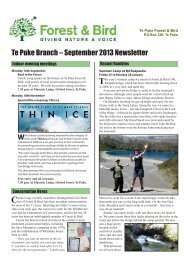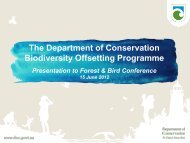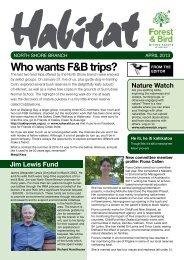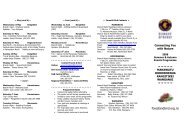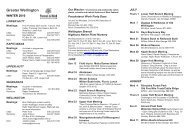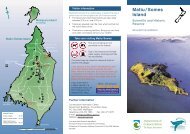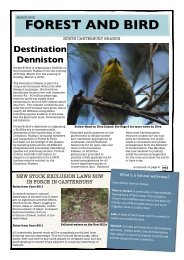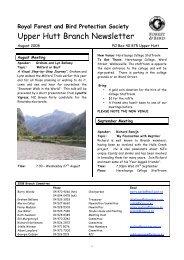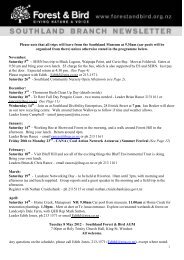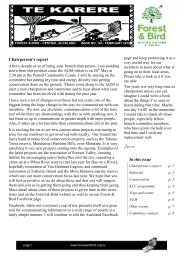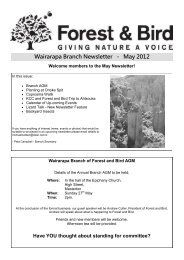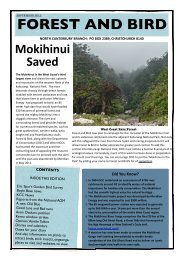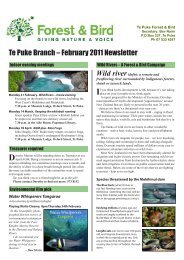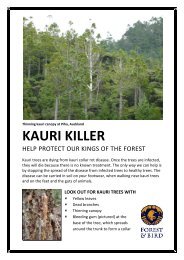Ashburton - Forest and Bird
Ashburton - Forest and Bird
Ashburton - Forest and Bird
You also want an ePaper? Increase the reach of your titles
YUMPU automatically turns print PDFs into web optimized ePapers that Google loves.
Kanuka planting at the Harris Reserve<br />
The Harris Scientific Reserve at Lovetts Road,<br />
Maronan, was a scene of great activity on Sept 4 th<br />
as about 250 people planted 2800 trees to<br />
augment the 2000 (mostly kanuka) plants already<br />
planted there by the <strong>Ashburton</strong> Community<br />
Conservation Trust (which was formed by <strong>Forest</strong><br />
& <strong>Bird</strong>). This big increase in the planting in the<br />
reserve has come about thanks to the Living<br />
Legends project.<br />
Living Legends was set up as part of the Rugby<br />
World Cup, <strong>and</strong> nationally, funding has been<br />
made available for 17 native plant restoration<br />
projects. The Harris Reserve is one of the sites<br />
chosen to participate. Our local Living Legend,<br />
ex-All Black Jock Ross, was on h<strong>and</strong> to help<br />
“draft” groups of helpers into the paddock to begin<br />
the planting.<br />
This is a huge boost to the development of the<br />
Harris Reserve <strong>and</strong> with ongoing support from<br />
Living Legends we will make progress much faster<br />
than previously expected. Conditions at the<br />
reserve are quite extreme, with low fertility soil<br />
which tends to dry out quickly. This site is one of<br />
only a h<strong>and</strong>ful of such Canterbury Dryl<strong>and</strong><br />
ecosystems still in existence, <strong>and</strong> as such is an<br />
important indicator of how the plains looked<br />
before settlement. It has also become a repository<br />
for plants that are fast disappearing.<br />
Thank you to all those people who helped prepare<br />
the site, then plant, water, <strong>and</strong> mulch the trees. It<br />
was very inspiring to see the transformation from<br />
bare paddock to a veritable forest of young trees,<br />
<strong>and</strong> it was great to see the enthusiasm from young<br />
<strong>and</strong> old.<br />
Native planting at the new industrial area<br />
It is encouraging to see how well the native<br />
planting, including beech trees, at the new<br />
industrial area is progressing. The council is to be<br />
commended for their planting work at the site.<br />
Survey of native vegetation<br />
The <strong>Ashburton</strong> Community Conservation Trust<br />
formed by <strong>Forest</strong> <strong>and</strong> <strong>Bird</strong> has recently invited<br />
tenders from botanists to carry out a survey of the<br />
<strong>Ashburton</strong> District dryl<strong>and</strong> vegetation from SH72<br />
<strong>and</strong> between the Rangitata <strong>and</strong> the Rakaia Rivers.<br />
A previous survey completed in 1996 identified<br />
many sites throughout the District where<br />
indigenous (native) vegetation was still existing.<br />
This data was available at the time of writing the<br />
original <strong>Ashburton</strong> District Plan <strong>and</strong> appeared<br />
to recognise the plight of these often tiny<br />
remnants. A rule was included which stated that<br />
there should be no clearance of indigenous<br />
vegetation on Rural A <strong>and</strong> B l<strong>and</strong> (7.6.5.1.13).<br />
A mature kanuka on the Lovetts Road which may<br />
be hundreds of years old<br />
Unfortunately this clause has had no ability to<br />
protect those remnants <strong>and</strong> we have seen native<br />
vegetation removed or lost due to other l<strong>and</strong> use<br />
<strong>and</strong> neglect often on public l<strong>and</strong>. The remnants<br />
remaining, because there are so few of them in the<br />
<strong>Ashburton</strong> District, are now regarded as being<br />
significant sites. An example is the<br />
meuhlenbeckia on the fence at Hinds School.<br />
The Canterbury Water Management Strategy <strong>and</strong><br />
the Canterbury Biodiversity Strategy recognise<br />
concerns about the loss of plains indigenous<br />
vegetation <strong>and</strong> as a result we were able to suggest<br />
to the District Council Biodiversity Action Plan<br />
that before decisions are made regarding<br />
Kanuka planting day at the Harris Reserve<br />
managing the remaining indigenous plantlife <strong>and</strong><br />
Royal <strong>Forest</strong> <strong>and</strong> <strong>Bird</strong> Protection Society – <strong>Ashburton</strong> Branch<br />
3



